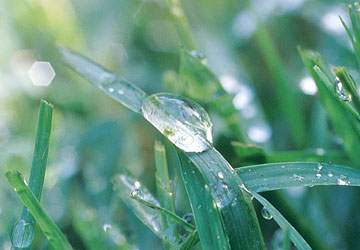- Home
- Learn about salinity
- Get to know your site
- Design a landscape
- Solve a problem
- Other information
Salinity Management Guide

All waters used to irrigate, be they recycled or otherwise, contain in dissolved form various compounds of salt — the familiar sodium chloride and others, such as sodium sulfate, magnesium sulfate, and calcium carbonate.
Salt exists in water as ions. Up to a certain amount of the ions can be helpful to plants. During absorption and transpiration of water, plants obtain some of the ions they need to survive and grow.
Recycled water typically contains more of some nutrients, such as nitrogen, phosphorus, and potassium, than the water from which it originated. As a result, irrigating with recycled water often lessens the need to add fertilizers containing these nutrients.
| Element | Role |
|---|---|
| Nitrogen | Helps plants to produce new, green growth |
| Phosphorus | Promotes growth of roots |
| Potassium | Contributes to overall hardiness, helping plants to resist extreme temperatures, pests, and diseases |
| Sulfur | Helps plants to produce protein and maintain their dark green color |
| Calcium | Helps plants to produce protein, promotes growth of roots, and contributes to overall vigor |
| Magnesium | Helps plants to use light to make food, to absorb other nutrients, and to make seeds |
| Iron | Helps plants to photosynthesize and to form chlorophyll |
| Manganese | Helps plants to form chlorophyll and to conduct essential cellular functions |
| Chloride | Helps plants to metabolize |
| Boron, cobalt, copper, zinc | Help plants with certain natural processes, such as absorbing nutrients, growing new tissue, metabolizing, and forming chlorophyll |
Beyond that nutritional amount, less is more. The less salt present in the water used to irrigate, the more likely the water will not harm plants.
When the salt in irrigation water accumulates to excess, one or more of the following scenarios may ensue:
- The osmotic effect induced by a relatively high amount of salt may adversely affect less-salt-tolerant plants.
- Excessive concentrations of certain ions may adversely affect less-tolerant plants.
- An excessive accumulation of sodium in the soil may alter the soil, rendering it less able to sustain plants.
| « Previous module | Next page » |